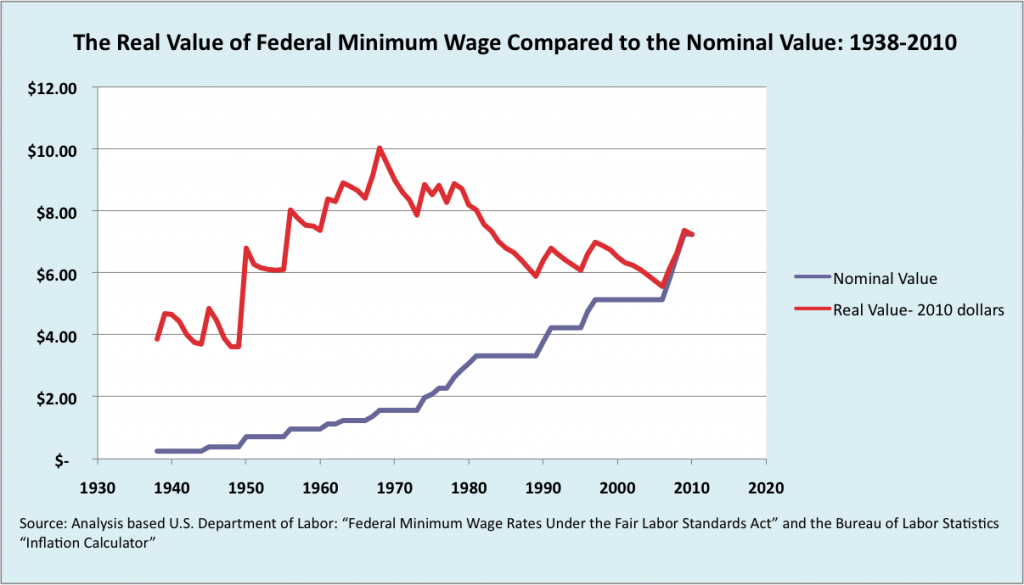
(Image courtesy of Just Economics)
Residents of the small city of SeaTac, Washington, will vote in November on a ballot initiative to raise the minimum wage to $15 an hour. If approved, it would surpass the highest minimum wage in the country, San Francisco’s $10.55, by $4.45. Home of Washington’s biggest airport and thousands of workers who cater to travelers in restaurants and hotels, one in 10 SeaTac residents live below the poverty line. The state’s current minimum is $9.19 an hour.
Across the country in Baltimore protesters have been targeting McDonald’s restaurants, demanding that the corporation raise its wages. Employees make as little as $7.25 and hour, the federal minimum. Maryland has no local or state minimum wage laws of its own, and federal lawmakers in Washington, D.C., haven’t upped the wage since 2007. Just 40 miles from the nation’s capital, more than one in five Baltimore residents live in poverty.
| Targeting minimum wage laws at the local level has become the preferred strategy among activists because of the federal government’s lack of action. |
SeaTac and Baltimore are just two of dozens of cities and counties across the country that are considering increases to the minimum wage. Labor unions and community groups in Chicago, Berkeley (California), Boston, Houston, Cleveland, and many smaller cities gathered on July 24 to call attention to the plight of low-wage workers, and to push local officials toward passing strong minimum wage ordinances. Targeting minimum wage laws at the local level has become the preferred strategy among activists because of the federal government’s lack of action.
Since President Barack Obama took office in 2008, his administration has proven incapable of advancing minimum wage legislation in the Congress. “I will keep making the case that we need to raise a minimum wage that in real terms is lower than it was when Ronald Reagan took office,” promised Obama at a rally in Illinois recently. Doing so will prove difficult, however, as little has changed in the balance of power in the Congress, with nearly all Republicans and some Democrats rejecting a pay hike for low-income workers.
Gene Sperling and Alan Kreuger, two of president Obama’s top economic advisors, released a statement on July 24 saying that, “The economic case for a minimum wage increase is clear.” They cited gains in worker well being, the economic multiplier effect of higher wages for low-income workers, and reduced “churn” of employees for businesses.
Krueger, a Princeton economist, made a name for himself in the 1990s studying the impact of minimum wage laws on the economy. In 1992, Krueger published a study showing that in the Texas fast-food industry the imposition of higher minimum wages the year before not only increased employment, but the law had no effect on the prices of food.
Krueger then studied New Jersey’s 1992 minimum wage increase from $4.25 to $5.05 an hour. Krueger and co-author David Card compared the impact of these pay increases to fast-food restaurants in nearby Pennsylvania where no minimum wage increase lifted restaurant employees. Based on data from 410 employers they concluded that, “Our empirical findings challenge the prediction that a rise in the minimum reduces employment. Relative to stores in Pennsylvania, fast food restaurants in New Jersey increased employment by 13 percent.”
Over 75 years the real value of the minimum wage rose and fell with the power of labor unions. Minimum wage’s value peaked in 1968 at $10.53 in constant (2012) dollars. Afterward it collapsed to a low of $6.25 in 1989 (again in 2012 dollars), and has stagnated since.
The decline of the minimum wage partly explains the explosive levels of inequality between most workers and the elite in America today. The top 1 percent of America’s income earners have captured 62 percent of all real income growth between 1993 and 2011, according to data compiled by Emanuel Saez of University of California at Berkeley. The real incomes of the bottom 99 percent have only grown by 6 percent over the same period.
For those who make the federal minimum wage, or earn various state and local minimum wages, their incomes have actually decreased while the cost of living increased.
Darwin Bondgraham is a sociologist and journalist who writes about political economy. His writing has appeared in Counterpunch, Truthout, Z Magazine and others. Follow him @DarwinBondGraham.





0 Comments